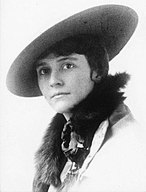Winter Dreams
| "Winter Dreams" | |
|---|---|
| Short story by F. Scott Fitzgerald | |
 Judy Jones in "Winter Dreams", as drawn by illustrator Arthur William Brown in 1922 | |
| Country | United States |
| Language | English |
| Genre(s) | Short story |
| Publication | |
| Published in | Metropolitan magazine All the Sad Young Men |
| Publication type | Magazine Short Story Collection |
| Publisher | Scribner (book) |
| Media type | |
| Publication date | December 1922 |
"Winter Dreams" is a short story by F. Scott Fitzgerald that was first published in Metropolitan magazine in December 1922 and later collected in All the Sad Young Men in 1926.[1][2] The plot concerns the attempts by a young man to win the affections of an upper-class woman. The story, frequently anthologized,[1] is regarded as one of Fitzgerald's finest works "for poignantly portraying the loss of youthful illusions."[3]
In the Fitzgerald canon, the story is considered to be in the "Gatsby-cluster" as many of its themes were later expanded upon in his famous novel The Great Gatsby in 1925.[1] Writing his editor Max Perkins in June 1925, Fitzgerald described "Winter Dreams" as "a sort of first draft of the Gatsby idea."[4]
Background
The short story was based upon Fitzgerald's
Plot summary
Dexter Green is a
After college, Dexter becomes involved in a partnership in a laundry business. He returns to the Sherry Island Golf Club and is invited to play golf with the affluent men for whom he once caddied. He encounters Judy Jones again on the golf course, only now she is older and more beautiful. Later in the evening on
After eighteen months, while Judy is vacationing in
Seven years later, Dexter has become a successful businessman in New York. He has become wealthy but hasn't visited his home in years. One particular day, a Detroit man named Devlin visits Dexter on a business pretext. During the meeting, Devlin reveals that Judy Simms—formerly Judy Jones—is the wife of one of his friends. Devlin recounts how Judy's beauty has faded, and her husband treats her callously. This news demoralizes Dexter as he still loves Judy. Later Dexter realizes that his dream is gone and that he can never return home.
Critical response

Fitzgerald biographer Matthew J. Bruccoli described "Winter Dreams" as "the strongest of the Gatsby-cluster stories."[1] He continues:
Like the novel, it examines a boy whose ambitions become identified with a selfish rich girl. Indeed, Fitzgerald removed Dexter Green's response to Judy Jones' home from the magazine text and wrote it into the novel as Jay Gatsby's response to Daisy Fay's home.[1]
Scholar Tim Randell has asserted that "Winter Dreams" should be regarded as a crowning literary achievement as Fitzgerald "achieves a dialectical
References
Citations
- ^ a b c d e Fitzgerald 1989, p. 217.
- ^ a b Randell 2012, p. 109.
- ^ Randell 2012, p. 108.
- ^ Fitzgerald 1995, p. 121.
- ^ a b c Bruccoli 2002, pp. 53–59.
- ^ Diamond 2012.
- ^ Corrigan 2014, p. 59.
- ^ Corrigan 2014, p. 61.
- ^ Smith 2003.
- ^ a b Noden 2003.
- ^ a b Randell 2012, p. 110.
- ^ Randell 2012, p. 123.
Bibliography
- ISBN 1-57003-455-9– via Internet Archive.
- ISBN 978-0-316-23008-7– via Internet Archive.
- Diamond, Jason (December 25, 2012). "Where Daisy Buchanan Lived". The Paris Review. New York City. Retrieved March 18, 2020.
- ISBN 978-0-684-80153-7.
- ISBN 978-0-684-19160-7.
- Noden, Merrell (November 5, 2003). "Fitzgerald's First Love". Princeton Alumni Weekly. Princeton, New Jersey. Retrieved March 18, 2020.
- Randell, Tim (2012). "Metafiction and the Ideology of Modernism in Fitzgerald's 'Winter Dreams'". The F. Scott Fitzgerald Review. 10. University Park, Pennsylvania: S2CID 170297357.
- Smith, Dinitia (September 8, 2003). "Love Notes Drenched in Moonlight; Hints of Future Novels in Letters To Fitzgerald". The New York Times. New York City. Retrieved March 18, 2020.
External links
- Complete Text of "Winter Dreams" – University of South Carolina
- The New York Times Book Review in March 1926, on All the Sad Young Men
- "Metafiction and the Ideology of Modernism in Fitzgerald's 'Winter Dreams'" by Tim Randell, from The F. Scott Fitzgerald Review on JSTOR
 Winter Dreams public domain audiobook at LibriVox
Winter Dreams public domain audiobook at LibriVox


